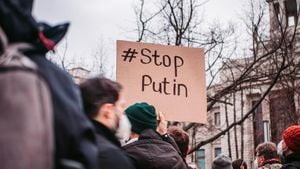The world braced for changes as Donald Trump returned to the White House, marking his second presidential term, and with it, his aggressive foreign policy tactics. Amid the discussions of tariffs, trade wars, and fluctuated alliances, fluctuations are expected to sculpt the global order distinctly. Early reactions revealed stark concerns from countries worldwide both near and far, especially those heavily reliant on trade with the U.S. For many, the big question was how Trump’s so-called "America First" policy would spill over borders, influencing everything from economies to military engagements.
Economic upheaval loomed large as Trump’s commitment to reinstate tariffs had the potential to ignite renewed hostilities, particularly with China and European nations. The narrative Trump spun during his campaign centered on blaming China for various economic woes, and Democrats feared returning to the days of uncertainty and backlash U.S. trade partners felt under his previous administration.
“Trade fragmentation entails sizable output losses,” stated Philip Lane, chief economist of the European Central Bank. Lane's analysis indicated repercussions the U.S. election results could have on global output, estimating impacts between 2% for partial trade restrictions to nearly 10% with more stringent measures imposed.
Compounding these challenges was the heavy debt burden many transitioning economies were already shouldering. Countries including Argentina and Ghana appeared especially vulnerable to ripple effects from U.S. policy shifts, as Reza Baqir highlighted, positing, “Trump’s anticipated policy changes will likely push the Federal Reserve to pause rate cuts.” Such pauses could complicate already precarious economic conditions for nations with fewer domestic capital sources.
“Default risk never left the building,” said Martin Bercetche, signaling broad concerns about the debt habits of more vulnerable nations. Although high-yielding bonds surfaced as one of the brighter spots amid global market turmoil, their long-term viability hinged heavily on how drastic Trump’s second term would play out.
Yet, not all chatter surrounding Trump's presidency centered solely on negative prospects. Some experts noted shift possibilities where smaller nations might benefit from faster growing U.S. trade diverted from China. Investors viewed regions with fiscal reforms or endings to prolonged global unrest as potential hotspots for investment success.
The global arms industry stood on edge as Trump reiterated intentions to “end global wars,” though details remained murky. The U.S. has held the title of world’s leading arms exporter with firearms sales skyrocketing during recent conflicts, and many wondered how his proposed policies might knit together arms sales, foreign affairs, and overall economic health.
Altaf Moti, writing for Eurasia Review, noted the intersection of Trump’s promises with current U.S. economic realities. U.S. foreign military sales reached $80.9 billion, and this foundation served as a backdrop for both military strategy and stronger alliances with allies wary of acceptable trade adjustments. With rumors circulating of dramatically cutting back on foreign involvement, the arms industry had to be nimble when adapting to forthcoming shifts.
Critics voiced their concerns about possible adverse ramifications, emphasizing how suddenly cutting foreign military ties might embolden adversarial nations like Russia. The tectonic geopolitical shifts expected included heightened tensions within NATO due to defensive funding disputes, all the more leading allies to scramble for how best to support homegrown military bases.
“With potentially reduced foreign sales, arms manufacturers may need to rely more heavily on domestic military contracts,” cautioned Moti, illuminating economic dependencies those manufacturers might face. Should major changes occur, U.S. military contracts could be the lifeblood for many companies still reeling from risks abroad.
Internal dynamics around tariffs created similar waves among corporations and consumers. The proposed return of broader tariffs sparked worry as many firms pondered the impacts on their supply chains and cost structures. American producers found themselves tackling prices likely inflamed by such policy changes, along with potential retaliatory tariffs from other countries.
First up on the list of concerns was the little-understood yet consequential effect of inflation on end-user pricing; consumers braced for the impact as producers adjusted prices. “It is unlikely producers will absorb all the production costs alone,” explained analysts, stressing how adjustment measures could lead U.S. operations to hightail it elsewhere.
“Finding substitutes for China is not realistically easy because China’s massive pool of labor and established supply chains create barriers,” said one expert, laying out complications facing businesses when trying to dictate future routes around impending tariffs and price changes.
For the EU, restoring trade discussions with Latin America served as both strategy and necessity, increasingly drawing away from current U.S. markets. The EU's measures sought to solidify security against unpredictability stemming from the Trump administration as leaders united to fortify alliances and reduce economic dependence on both the U.S. and China.
Countries like the ASEAN nations, including Cambodia, have also begun evaluating options for potential partnerships to cushion against U.S. tariffs and regulations. Observers saw broader moves surfacing as nations readied to spread their economic wings and absorb potential shocks.
Trump’s administration plans have installments expecting high stakes for allies as they scramble to fulfill new financial commitments—even expecting transactional payments if these remarks resurrect any essence of American dominance.
“Trump would continue to move forward with hardcore tariff policies,” one analyst posited. With this realization, allies and trading partners faced timely examinations of their relationships, ensuring all were prepared as potential policy impacts reverberated throughout. “Countries would need to be vigilant,” they added, fundamental as modern political eras began laying foundations for potentially severe redefining of international relationships.
Despite all of the challenges posed by the possible new 2.0 presidency, observers held onto the belief of how those changes might ignite more negotiations, aligning some long-time rivals toward constructive talks.



